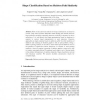Free Online Productivity Tools
i2Speak
i2Symbol
i2OCR
iTex2Img
iWeb2Print
iWeb2Shot
i2Type
iPdf2Split
iPdf2Merge
i2Bopomofo
i2Arabic
i2Style
i2Image
i2PDF
iLatex2Rtf
Sci2ools
122
Voted
EMMCVPR
2007
Springer
2007
Springer
Shape Classification Based on Skeleton Path Similarity
Most of the traditional methods for shape classification are based on contour. They often encounter difficulties when dealing with classes that have large nonlinear variability, especially when the variability is structural or due to articulation. It is well-known that shape representation based on skeletons is superior to contour based representation in such situations. However, approaches to shape similarity based on skeletons suffer from the instability of skeletons and matching of skeleton graphs is still an open problem. Using a skeleton pruning method, we are able to obtain stable pruned skeletons even in the presence of significant contour distortions. In contrast to most existing methods, it does not require converting of skeleton graphs to trees and it does not require any graph editing. We represent each shape as set of shortest paths in the skeleton between pairs of skeleton endpoints. Shape classification is done with Bayesian classifier. We present excellent classification...
Related Content
| Added | 07 Jun 2010 |
| Updated | 07 Jun 2010 |
| Type | Conference |
| Year | 2007 |
| Where | EMMCVPR |
| Authors | Xingwei Yang, Xiang Bai, Deguang Yu, Longin Jan Latecki |
Comments (0)

